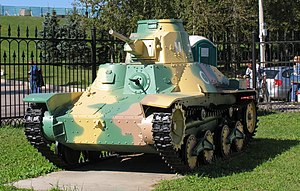
Back Tip 95 Ha-Qo yüngül tankı Azerbaijani 95 Ха-Го Bulgarian Type 95 Ha-Go Breton Type 95 Ha-Go BS Typ 95 Ha-gó Czech Typ 95 Ha-Gō German Tipo 95 Ha-Go Spanish Tyypin 95 kevyt panssarivaunu Ha-gō Finnish Type 95 Ha-Go French Tip 95 Ha-Go Croatian
| Type 95 Ha-Gō | |
|---|---|
 Type 95 at the Moscow Museum of the Great Patriotic War | |
| Type | Light tank |
| Place of origin | Japan |
| Service history | |
| Used by | See Operators |
| Wars | Second Sino-Japanese War Battles of Khalkhin Gol Second World War Chinese Civil War |
| Production history | |
| Designed | 1933–1934 |
| Unit cost | 71,000 yen ($19,078 USD) in August 1939, excluding armaments[1][2] |
| Produced | 1936–1943[3] |
| No. built | 2,300[3] |
| Specifications | |
| Mass | 7.4 t (7.3 long tons; 8.2 short tons)[4] |
| Length | 4.38 m (14 ft 4 in)[4] |
| Width | 2.06 m (6 ft 9 in)[5] |
| Height | 2.13 m (7 ft 0 in)[5] |
| Crew | 3[4] |
| Armour | 12 mm (turret front, turret sides, turret rear, hull front, hull sides) 6-9 mm (rear and roof)[4] |
Main armament | Type 94 (1934) 37 mm tank gun[5] |
Secondary armament | 2 × 7.7 mm Type 97 machine gun[6] |
| Engine | Mitsubishi A6120VDe air-cooled inline 6-cylinder 14.4 L diesel 120 hp (90 kW) at 1800 rpm[6] |
| Power/weight | 16 hp/tonne |
| Suspension | Bell crank |
Operational range | 209 kilometers[5] |
| Maximum speed | 45 km/h (28 mph) on road[5] |
The Type 95 Ha-Gō (九五式軽戦車 ハ号, kyūgo-shiki kei-sensha Ha-Gō, also known as the Ke-Go[7]) was a light tank used by the Empire of Japan during the Second Sino-Japanese War, at the Battles of Khalkhin Gol against the Soviet Union, and in the Second World War. It proved sufficient against infantry but was not effective against other tanks.[8] Approximately 2,300 were produced,[3] making it the most numerous Japanese armoured fighting vehicle of the Second World War.
- ^ "兵器臨時定価、予価、表送付の件 Military catalogue of the Japanese military". National Archives of Japan. Ministry of the Army.
- ^ "Banking and Monetary Statistics, 1914-1941, Part I". Federal Reserve Bank of St. Louis. Board of Governors of the Federal Reserve System (U.S.). January 1943 [1943].
- ^ a b c Zaloga 2007, pp. 10, 17.
- ^ a b c d Tomczyk 2002, p. 74.
- ^ a b c d e Zaloga 2007, p. chart D.
- ^ a b Tomczyk 2002, p. 67.
- ^ Tomczyk 2002, p. 64.
- ^ Zaloga 2008, pp. 16, 18.